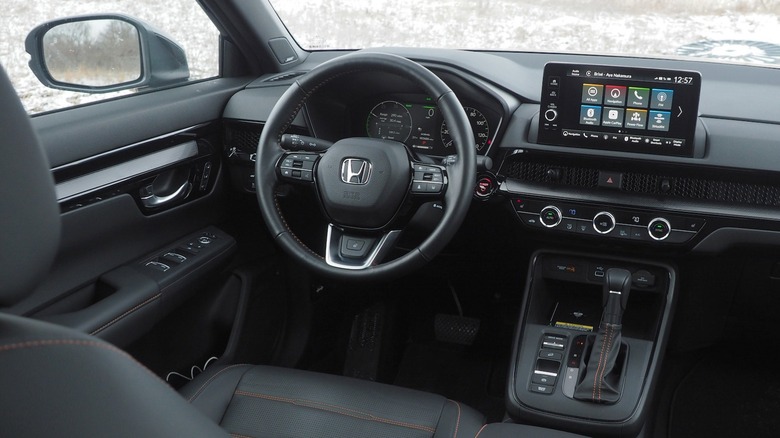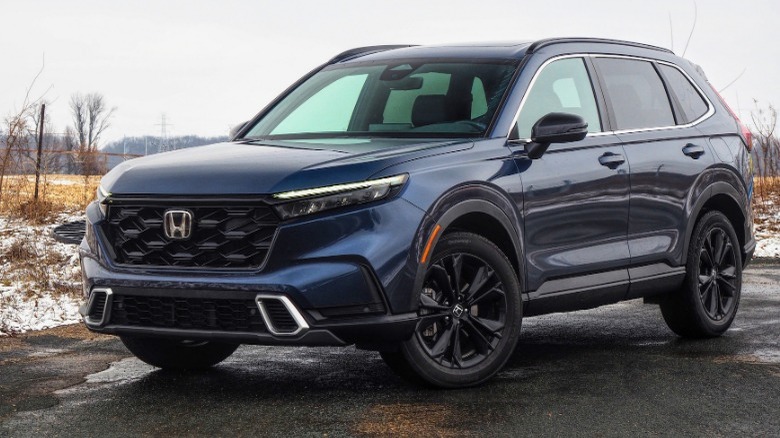3 Features Not Included With Honda Sensing That Might Be Worth The Upgrade
Advanced Driver Assistance Systems, or ADAS, have gone from being the preserve of high-end luxury vehicles to commonplace on the most affordable cars. Increasingly required as part of more stringent safety testing, or seen as a must-have feature to keep automakers' ranges competitive, what once could've added thousands of dollars to the sticker price is often now included on even base trims.
Honda Sensing is a good example of that. Only a few years ago, features like adaptive cruise control and lane-keeping assistance would've been added extras. Now, models like the 2023 Honda CR-V Hybrid include the ADAS suite by default.
That's not to say automakers like Honda are giving away all their most cutting-edge safety technology away for free, mind. There are often still some options that require an upgrade, even for a fairly comprehensive package like Honda Sensing.
Blind Spot Information System (BSIS)
Arguably one of the most useful additions to the ADAS portfolio over the past decade has been the Blind Spot Information System. Otherwise known as blind-spot warnings, alerts, or notifications, the technology monitors the adjacent lane for traffic. If there's a vehicle in your blind spot, the car can identify that even if the human driver doesn't see it.
On Honda's cars, this system lights up an LED at the side mirror as a subtle indicator that there's a vehicle alongside. If you still switch on your turn signal, meanwhile, the light blinks and you'll get an audible warning that now might not be the safest time for a maneuver.
Given the increasing size of modern vehicles, there's a solid argument to be made that a Blind Spot Information System is almost essential. Honda clearly agrees in some cases, making the technology standard on some of its vehicles like the 2023 CR-V.
Cross Traffic Monitor
Figuring out what's happening around the car — at times in locations where human drivers simply can't see — is a big advantage of ADAS technology. That goes doubly so when it comes to reversing the vehicle. Reversing cameras have been mandatory on new models sold in the U.S. since mid-2018 after the National Highway Traffic Safety Administration (NHTSA) added them to its list of required safety features. However, that's not the only tool in the automakers' kit bag.
Cross Traffic Monitor, also known as rear-collision warning, adds other sensors into the mix. If there's a vehicle approaching from the left or right, while your Honda is in reverse, you'll get a series of audible alerts as well as on-screen graphics.
It's particularly useful in parking lots, where you may be reversing out of a space into the path of other traffic. Visibility from the driver's seat in that situation could well be blocked by other parked cars, meaning the sensors have an early advantage before you inadvertently reverse into another vehicle.
Auto High-Beam Headlights
Figuring out car lights used to be relatively easy: when it got dark, you turned them on. With the prevalence of daytime running lights — or DRLs — however, it's not uncommon to see drivers assuming their headlights are switched on when they're not. Add in confusion over when to use high-beam headlights — and when to switch them off — and it's no surprise that visibility can be impacted.
Auto High-Beam Headlights aren't part of Honda Sensing, but Honda does offer them on select models like the 2023 Accord. The technology builds on automatic headlights, which can be set to switch on when it gets dark, and then off again when it brightens again.
If the car is traveling at over 25 mph, and there's no oncoming traffic, the high beams will automatically be enabled. Should another vehicle approach, the system switches back to low beams to avoid dazzling that driver. Sounds simple, but it could make night driving a whole lot safer.

